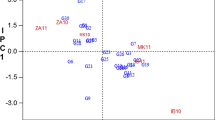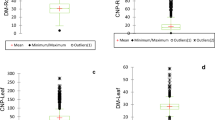Abstract
About 70 million people obtain more than 500 cal per day from cassava roots. The crop is fundamental as food security of poor rural communities, but little is known about variability of root nutritional and quality traits. Roots from 2457 genotypes comprising landraces and improved clones, were screened for their nutritional (cyanogenic potential, carotene, minerals, and sugars contents) and agronomic (dry matter content, color intensity, and postharvest physiological deterioration) traits. The objective was to assess the range of variation for the traits evaluated to define future research strategies. Results are mostly based on unreplicated measurements. Carotene contents in the roots ranged from 0.102 to 1.040 mg/100 g fresh tissue and correlated positively with color intensity (ρ = 0.860) and cyanogenic potential (ρ = 0.305). Average levels of Fe and Zn were 17.1 and 7.5 mg/kg, respectively. Many clones derived from Meso-America showed high protein levels in the roots, probably as a result of the introgression from wild relatives only found in that region. The observed values for carotene, proteins and minerals contents suggest the potential for improving the nutritive value of cassava.
Similar content being viewed by others
Abbreviations
- PPD:
-
postharvest physiological deterioration
- HCN:
-
cyanogenic potential
- VAD:
-
Vitamin A deficiency
References
ACC/SCN, 1992. Second report on the world nutrition situation. United Nations, Administrative Committee on Coordination, Subcommittee on nutrition. Geneva. ACC/SCN in collaboration with IFPRI.
ACC/SCN, 2000. Forth report on the world nutrition situation. United Nations, Administrative Committee on Coordination, Subcommittee on nutrition. Geneva. ACC/SCN in collaboration with IFPRI.
Allen, C.A., 1994. The origin of Manihot esculenta Crantz (Euphorbiaceae). Gen Res Crop Evol 41: 133–150.
Babu, L., & S.R. Chatterjee, 1999. Protein content and amino acid composition of cassava tubers and leaves. J Root Crops 25(20): 163–168.
Beaton, G.H., R. Martorell, K.J. Aronso, B. Edmonston, G. McCabe, A.C. Ross & B. Harvey, 1993. Effectiveness of vitamin A supplementation in the control of young child morbidity and mortality in developing countries. ACC/SCN State of the arts series, Nutrition Policy Paper No. 13. Geneva.
Beeching, J.R., H. Yuanhuai, R. Gómez-Vázquez, R.C. Day & R.M. Cooper, 1998. Wound and defense responses in cassava as related to post-harvest physiological deterioration. In: J.T. Romeo, K.R. Downum & R. Verpoorte (Eds.), Recent Advances in Phytochemistry (vol. 32). Phytochemical Signals in Plant-Microbe Interactions, pp. 231–248. Plenum Press, New York, London.
Brücher, H. 1989. Useful Plants of Neotropical Origin and Their Wild Relatives. Springer-Verlag, Berlin and New York, p. 296.
Buitrago, A.J.A., 1990. La yuca en la alimentación animal. Centro Internacional de Agricultura Tropical (CIAT), Cali, Colombia p. 446.
Buschmann, H., M.X. Rodriguez, J. Tohme & J.R. Beeching, 2000. Accumulation of hydroxycoumarins during post-harvest deterioration of tuberous roots of cassava (Manihot esculenta Crantz). Ann Bot 86: 1153–1160.
CIAT, 1999. Improved Cassava for the Developing World. Annual Report, 1999.
CIAT, 2001. Improved Cassava for the Developing World. Annual Report, 2001.
CIAT, 2002. Improved Cassava for the Developing World. Annual Report, 2002.
Cock, J., 1985. Cassava. New Potential for a Neglected Crop. Westview Press, Boulder, CO., USA.
Combs, G.F., 1998. The Vitamins. Fundamental Aspects in Nutrition and Health. Academic Press. p. 618.
Cronin, D.A. & S. Smith, 1979. A simple and rapid procedure for the analysis of reducing, total and individual sugars in potatoes. Potato Res. 22: 99–105.
El-Sharkawy, M.A., 1993. Drought-tolerant cassava for Africa, Asia and Latin America. BioScience 43: 441–451.
Essers, A.J.A.M., R.M. Bosveld, R.M. van der Gift & A.G.J. Voragen, 1994. A new chromogen for the assay of cyanogens in cassava products. In: M.O. Akoroda (Ed.), Root crops for food security in Africa. Proceedings of the Fifth Triennal Symposium of the International Society for Tropical Root Crops, African Branch (ISTRC-AB), The Technical Centre for Agricultural and Rural Cooperation (CTA) and International Institute of Tropical Agriculture (IITA), Ibadan, Nigeria, pp. 314–317.
FAO/FIDA, 2000. La economía mundial de la yuca. Hechos, tendencias y perspectivas. Fondo Internacional de Desarrollo Agrícola. Organización de las Naciones Unidas para la Agricultura y la Alimentación. Roma, Italia.
García-Casal, M.N., M. Layrisse, L. Solano, M.A. Baron, F. Arguello, D. Llovera, J. Ramirez, I. Leets & E. Tropper, 1998. Vitamin A and beta-carotene can improve nonheme iron absorption from rice, wheat, and corn by humans. J Nutr Bethesda 128(3): 646–650.
Gomez, G., J. Santos & M. Valdivieso, 1983. Utilización de raíces y productos de yuca en alimentación animal. In: C.E. Domínguez (Ed.), Yuca: Investigación, producción y utilización. Working Document No. 50. Centro Internacional de Agricultura Tropical (CIAT), Cali, Colombia.
Graham, R.D. & J.M. Rosser, 2000. Carotenoids in staple foods: Their potential to improve human nutrition. Food Nut Bull 21(4): 404–409.
Graham, R.D., D. Senadhira, S. Beebe, C. Iglesias & I. Monasterio, 1999. Breeding for micronutrient density in edible portions of staple food crops: Conventional approaches. Field Crop Res 60: 57–80.
Hock-Hin, Y. & T. Van-Den, 1996. Protein contents, amino acid compositions and nitrogen-to-protein conversion factors for cassava roots. J Sci Food Agric 70: 51–54.
Iglesias, C., J. Mayer, A.L. Chávez & F. Calle, 1997. Genetic potential and stability of carotene content in cassava roots. Euphytica 94: 367–373.
Jalal, F., M.C. Nesheim, Z. Agus, D. Sanjur & J.P. Habitch, 1998. Serum retinol concentrations in children are affected by food sources of beta-carotene, fat intake, and anthelmintic drug treatment. J Clinical Nutr 68(3): 623–629.
Jennings, D.L. & C.H. Hershey, 1985. Cassava breeding: A decade of progress from international programs. In: G.E. Russell (Ed.), Progress in Plant Breeding, pp 89–116. Butterworths. London, Boston.
Kakes, P., 1990. Properties and functions of the cyanogenic sustem in higher plants. Euphytica 48: 25–43.
Kawano, K., W.M. Gonçalvez Fukuda & U. Cenpukdee, 1987. Genetic and environmental effects on dry matter content of cassava root. Crop Sci 27: 69–74.
Kawano, K., K. Narintaraporn, P. Narintaraporn, S. Sarakarn, A. Limsila, J. Limsila, D. Suparhan & W. Watananonta, 1998. Yield improvement in a multistage breeding program for cassava. Crop Sci 38: 325–332.
Kolsteren, P., S.R. Rahman, K. Hilderbrand & A. Diniz, 1999. Treatment for iron deficiency anemia with combined supplementation of iron, vitamin A and zinc in women of Dinajpur, Bangladesh. Euro J Clin Nutr 53(2): 102–106.
MI/UNICEF/Tulane University, 1998. Progress in controlling vitamin A deficiency. Ottawa: Micronutrients Initiative.
Mwanri, L., A. Worsley, P. Ryan & J. Masika, 2000. Supplemental vitamin A improves anemic school children in Tanzania. J Nut 130: 2691–2696.
Olsen, K.M. & B.A. Schaal, 2001. Microsatellite variation in cassava (Manihot esculenta, Euphorbiaceae) and its wild relatives: further evidence for a southern Amanzonian origin of domestication. Am J Bot 88: 131–142.
Renvoize, B.S., 1972. The area of origin of Manihot esculenta as a crop plant –a review of the evidence. Econ Bot 26: 352–360.
Rodriguez Amaya, D., 1989. Critical review of provitamin A determination in plant Foods. J Micronut Anal 5: 191–225.
Rodriguez Amaya, D., 1990. Provitamin A determination problems and possible solutions. Food Nut Bull 12(3): 246–250.
Rodriguez-Amaya, D.B., 2001. A guide to carotenoid analysis in foods. ILSI Press, Washington, pp. 64.
Safo-Katanga, O., P. Aboagye, S.A. Amartey & J.H. Olaham, 1984. Studies on the content of yellow-pigmented cassava. In: E.R. Terry, E.V. Doku, O.B. Arene & N.M. Mahungu (Eds.), Tropical Roots Crops Production and Uses in Africa, pp. 103–104. IDRC, Ottawa, Canada.
Scott, K.J. & D.J. Hart, 1993. Further observations on problems associated with the analysis of carotenoids by HPLC. Food Chem 47: 403–40.
Scott, G.J., M.K. Rosegrant & C. Ringler, 2000. Global projections for root and tuber crops to the year 2020. Food Policy 25: 561–597.
Van Oirschot, Q.E.A., G.M. O’Brien, D.D. Dufour, M.A. El-Sharkawy & E. Mesa, 2000. The effect of pre-harvest pruning of cassava upon root deterioration and quality characteristics. J Sci Food Agric 80: 1866–1873.
West, K.R. Jr., 2001. The magnitude of vitamin A deficiency disorders: Overview. XX IVACG Meeting. Hanoi, Vietnam. February 12–15.
Wheatley, C., C. Lozano & G. Gomez, 1985. Post-harvest deterioration of cassava roots, In: J.H. Cock & J.A. Reyes (Eds.), Cassava: Research, Production and Utilization. pp. 655-671. UNDP-CIAT, Cali.
WHO/UNICEF, 1995. Global prevalence of vitamin A deficiency. Micronutrient Deficiency Information System Working Paper 2. Geneva WHO.
Zapata, G., 2001. Disminución de deterioro fisiológico postcosecha en raíces de yuca (Manihot esculenta Crantz) mediante almacenamiento controlado. B.S. Thesis, Universidad de San Buenaventura, Facultad de Ingeniería Agroindustrial. Cali, Colombia.
Author information
Authors and Affiliations
Corresponding author
Rights and permissions
About this article
Cite this article
Chávez, A.L., Sánchez, T., Jaramillo, G. et al. Variation of quality traits in cassava roots evaluated in landraces and improved clones. Euphytica 143, 125–133 (2005). https://doi.org/10.1007/s10681-005-3057-2
Received:
Accepted:
Issue Date:
DOI: https://doi.org/10.1007/s10681-005-3057-2




